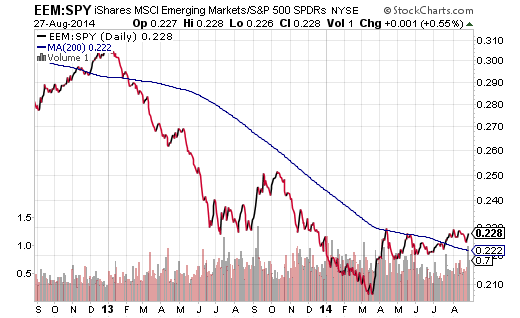Money managers like myself may not discuss it often, but they probably have an “Uh Oh Indicator.” What is it? When certain clients ask why any amount of cash rests in money market accounts – why more of the money is not being committed to the stock benchmark du jour (i.e., NASDAQ in 1999, MSCI Emerging Markets in 2007, S&P 500 in 2014) – unsavory greed is supplanting cautious enthusiasm.
Granted, there is nothing scientific about an “Uh Oh Indicator” sounding its bell. Nor is there any reason to believe that danger in risk assets are imminent. On the other hand, after 25 years of experience with financial services as well as psychology, I no longer regard “Trouble” as a board game produced by Hasbro; rather, a large percentage of the investing public is currently embracing a foolhardy notion that bad times exist in the rear-view mirror alone.
Even institutional analysts are developing new paradigms to explain away the probability of a shock to stocks. Fund management group, Lord Abbett, recently opined that extremely high profit margins for S&P 500 corporations are of little concern. They infer future stock market success based on structural changes like lower global tax rates for corporations, lower interest rates and improved technological efficiency.
Really? So we’re going back to the idea of a “New Economy” justifying excessive stock valuations? The last time that irrational folks traveled that direction (2000-2002), profit margins for the S&P 500 dipped from roughly 8.0% down to approximately 5.5%; the declines coincided with one of the most brutal stock bears investors had seen in 30 some-odd years. Similarly, as profit margins surged from 5.5% up to record levels of 9.5% through the mid-point of 2007, investors once more ignored the warning that margins revert to a mean. The 10/2007-3/2009 collapse in equities was as epic as any decline since the 1929 disaster and it coincided with profit margins dropping far below 7% (20-year historical average); margins actually bottomed out near 2.5%.
Every conceivable method of stock valuation (e.g., Tobin’s Q, 10-year Cyclically-Adjusted P/E, Current P/E, P/S, Market Cap/GDP, Dividend Model, etc.) suggests that stocks are overvalued. There is one exception, of course… Forward 12-month P/E. Yet the only way that Forward P/Es can approximate reality is if profit margins in 2014 consistently hang around their all-time highs of 10%+. In contrast, if we assume that they revert to a historical average, the Forward P/E would be as overvalued as the rest of the valuation models.
Permanently elevated profit margins… does that sound likely? When research shows that every economic expansion since World War II experienced slower growth in its second half relative to its first? When 2% dividend yields and 5% junk bond yields may have to face the prospect of a Federal Reserve that will “normalize” interest rates? When the percentage of adults in the U.S. workforce is declining? When recessions themselves cannot be entirely avoided? When inflation-adjusted family income is lower than it was five years ago?
Perhaps quantitative easing (e.g., QE1, QE2, Operation Twist, QE3) has convinced folks that prices of risk assets can only go higher. Perhaps a continuation of zero percent overnight lending rate policy deep into 2015 can propel U.S. stocks to new levels. On the flip side, we should not dismiss certain signals altogether. Sure the S&P 500 has hit yet another 52-week high, but so have long-term Treasuries via iShares Barclay’s 20+Year Treasury Bond Fund (TLT). Try as one may to explain price gains for long-term Treasuries as a function of more attractive yields than European sovereign debt, or the needs of large institutions, bond buyers clearly doubt the well-being of an economy without extraordinary accommodation by the Federal Reserve.
If we can accept the fact that U.S. stock prices have moved into “uh oh” territory, then we’re less likely to get burned when profit margins falter. I have owned strong contenders like SPDR Select Health Care (XLV) for many years. That said, when SPDR - Health Care (ARCA:XLV) falls below a 200-day moving average, I intend to reduce client exposure.
Perhaps ironically, foreign developed equities and emerging markets present more compelling valuations. They have traded at P/E and P/S discounts for the better part of the last five years. Only now, though, have investors been willing to increase their overseas allocations. The better “bet” seems to be with the emergers. Whereas the hope for developed Europe/Far East equities resides with the degree of central bank manipulation, the hope for emerging market stocks is more generally tied to organic growth. The iShares MSCI Emerging Markets (ARCA:EEM):S&P 500 SPDR Trust (SPDR S&P 500 (ARCA:SPY) price ratio demonstrates a five-and-a-half month upturn in emerging market relative strength.
Disclosure: Gary Gordon, MS, CFP is the president of Pacific Park Financial, Inc., a Registered Investment Adviser with the SEC. Gary Gordon, Pacific Park Financial, Inc, and/or its clients may hold positions in the ETFs, mutual funds, and/or any investment asset mentioned above. The commentary does not constitute individualized investment advice. The opinions offered herein are not personalized recommendations to buy, sell or hold securities. At times, issuers of exchange-traded products compensate Pacific Park Financial, Inc. or its subsidiaries for advertising at the ETF Expert web site. ETF Expert content is created independently of any advertising relationships.



